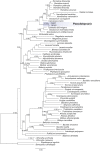Pseudolepraria, a new leprose genus revealed in Ramalinaceae (Ascomycota, Lecanoromycetes, Lecanorales) to accommodate Leprariastephaniana
- PMID: 37252052
- PMCID: PMC10210240
- DOI: 10.3897/mycokeys.96.98029
Pseudolepraria, a new leprose genus revealed in Ramalinaceae (Ascomycota, Lecanoromycetes, Lecanorales) to accommodate Leprariastephaniana
Abstract
The new genus Pseudolepraria Kukwa, Jabłońska, Kosecka & Guzow-Krzemińska is introduced to accommodate Leprariastephaniana Elix, Flakus & Kukwa. Phylogenetic analyses of nucITS, nucLSU, mtSSU and RPB2 markers recovered the new genus in the family Ramalinaceae with strong support. The genus is characterised by its thick, unstratified thallus composed entirely of soredia-like granules, the presence of 4-O-methylleprolomin, salazinic acid, zeorin and unknown terpenoid, and its phylogenetic position. The new combination, P.stephaniana (Elix, Flakus & Kukwa) Kukwa, Jabłońska, Kosecka & Guzow-Krzemińska, is proposed.
Keywords: Lichenized fungi; Neotropics; morphology; secondary metabolites; sterile lichens; taxonomy.
Martin Kukwa, Magdalena Kosecka, Agnieszka Jabłońska, Adam Flakus, Pamela Rodriguez-Flakus, Beata Guzow-Krzemińska.
Figures


References
-
- Aptroot A. (2002) New and interesting lichens and lichenicolous fungi in Brazil. Fungal Diversity 9: 15–45.
-
- Aptroot A, Cáceres MES. (2014) A key to the corticolous microfoliose, foliose and related crustose lichens from Rondônia, Brazil, with the description of four new species. Lichenologist 46(6): 783–799. 10.1017/S0024282914000358 - DOI
-
- Barcenas-Peña A, Diaz R, Grewe F, Widhelm T, Lumbsch HT. (2021) Contributions to the phylogeny of Lepraria (Stereocaulaceae) species from the Southern Hemisphere, including three new species. The Bryologist 124(4): 494–505. 10.1639/0007-2745-124.4.494 - DOI
-
- Bungartz F, Hillmann G, Kalb K, Elix JA. (2013) Leprose and leproid lichens of the Galapagos, with a particular focus on Lepraria (Stereocaulaceae) and Septotrapelia (Pilocarpaceae). Phytotaxa 150(1): 1–28. 10.11646/phytotaxa.150.1.1 - DOI
LinkOut - more resources
Full Text Sources
